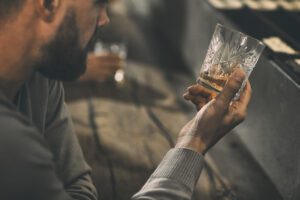Refuge Recovery is a program that aims to assist people in overcoming addiction and healing through mindfulness, meditation, and community support. In essence, Refuge Recovery provides a structured path to recovery, showing individuals the way to the inner causes of addiction and helping them to achieve a long-term change. Through this blog, we will discuss the Refuge Recovery steps, its process, and how they can be the key to life without addiction.
Steps In Refuge Recovery Process
Step 1: Recognizing Suffering
The first step in the refuge recovery process is the realization of the pain caused by addiction. The first step is to admit how addiction has influenced one’s life and the lives of the people around them. It necessitates a readiness to face the pain and turmoil that addiction brings and to take responsibility for one’s actions. It is through the recognition of the pain caused by addiction that people can start to understand the necessity of change and take the first steps toward recovery.
Step 2: Finding Refuge
After the suffering caused by addiction has been recognized, the next step is to find shelter or refuge. This entails looking for sources of help and advice that can assist people in dealing with the hardships of recovery. For most, this refuge is a community support group like Refuge Recovery, where people can get in touch with those who are on the same path. Refuge is also achieved by tapping into the inner resources like mindfulness and meditation which in turn provide strength and resilience to the addiction.
Step 3: Taking Refuge in the Four Truths
At the core of the Refuge Recovery process are the Four Truths, which serve as a guiding framework for recovery. These truths are:
-
Addiction creates suffering.
This truth acknowledges the deep influence of addiction on the addict and their family, thus, it calls for the understanding of the pain that addiction has created. Through facing the fact of this, people can start their way to healing and come out of the addiction.
-
The cause of addiction is repetitive craving.
The fact that most people cannot stop using drugs once they start indicates the strong desire that keeps the addiction going, which leads them to investigate their cravings and develop ways to liberate themselves from the grip of their addiction.
-
Recovery is possible.
This truth states that no matter what the previous hardships were, everyone can be transformed and healed. Through dedication and support, one can start the way to a life of freedom and health.
-
The path to recovery is available to anyone willing to undertake it.
This truth shows that regardless of background or circumstances, you can start a healing and change journey by following the principles of refuge recovery.
The Four Truths is the foundation that when you take refuge in them you are on the road to recovery. The fact that craving is the main problem in addiction and that recovery is possible shows that people can start to make a way to healing and transformation.
Step 4: Engaging in the Eightfold Path
The Four Truths provide the basis for the Refuge Recovery process and the next step in the Refuge Recovery steps is the Eightfold Path. The road chosen by a person offers a set of pre-defined rules for living a life free from the clutches of addiction, which are based on the principles of mindfulness, ethical conduct, and wisdom. The Eightfold Path includes:
- Understanding: Developing a process of understanding the nature of addiction and its causes.
- Intention: Having a well-defined intention to fight addiction and live a life that is shaped by the values of compassion and wisdom.
- Communication: The act of communicating openly and truthfully with oneself and others, not being influenced by the addiction.
- Action: The art of taking a well-planned and skillful action to build positive habits and behaviors that are useful for recovery.
- Livelihood: Choosing a livelihood that is by one’s values and supports the path of recovery.
- Effort: Attempting to constantly fight the addiction and the development of positive qualities like mindfulness and compassion.
- Mindfulness: The process of cultivating mindfulness through practices such as meditation can help people to be more aware of their thoughts and behaviors and thus, acquire more insights into their actions.
- Concentration: The development of concentration through practices such as meditation can be the key to the people who are the ones who can then solve the problems of recovery.
Step 5: Cultivating Mindfulness and Compassion
The core of the refuge recovery process is the development of mindfulness and compassion. The above-mentioned qualities are the key factors in the overcoming of addiction and the establishment of permanent change. Mindfulness implies the practice of being in the present moment with openness and curiosity and thus, people can see their thoughts and feelings without judgment. Compassion is the act of being kind and understanding both to oneself and others, as well as the realization of the common humanity that makes us all connected. Mindfulness and compassion can be the tools to develop the inner strength and resilience needed to overcome addiction and to live a life of freedom and fulfillment.
Step 6: Supporting Others on the Path
As one goes through the process of recovery, he or she is advised to help others who are also on the same road. This might be done by telling their own experiences, giving encouragement and advice, or simply being a supportive friend to those who require it. Through helping others in the recovery process, people can get a better knowledge about addiction and thus, become part of the recovery community.
Step 7: Continuing the Journey
Recovery is not a goal but a continuous path and the Refuge Recovery process is created to help people to be at every stage of this path. Regardless of whether they have just started their recovery or have been sober for many years, people are advised to keep on practicing mindfulness, developing compassion, and helping others on the road. By remaining in touch with the principles and practices of refuge recovery, people can keep on growing, healing, and transforming themselves in their lives.
FAQ’s
Que: How does Refuge Recovery differ from traditional 12-step programs like Alcoholics Anonymous (AA)?
Ans: Refuge Recovery is different from the conventional 12-step programs in several aspects. Although the two methods are designed to help individuals get over addiction, Refuge Recovery is based on Buddhist principles and stresses the importance of mindfulness, meditation, and compassion as the main elements of the recovery process. Besides, Refuge Recovery is a secular and non-theistic recovery program, thus, it is suitable for people of all religions and beliefs.
Que: Can I participate in Refuge Recovery even if I’m not familiar with Buddhist teachings or meditation?
Ans: Yes, absolutely! Refuge Recovery is made for people from different walks of life and beliefs. Although the program is based on Buddhist principles, you do not have to be a Buddhist or a practitioner of meditation to join it. Refuge Recovery is a place where people from different walks of life are accepted and everyone is given the help and advice to go through the process of recovery.
Que: How can I find a Refuge Recovery group or meeting in my area?
Ans: It is easy to search for a Refuge Recovery group or a meeting in your area. You can go to the Refuge Recovery website and use the meeting locator tool to find groups in your area. Besides, many communities have local organizations or resources that provide Refuge Recovery meetings or support groups. You can also contact the local mental health organizations or addiction treatment centers to get information on the refuge recovery groups in your area.
Conclusion
The Refuge Recovery steps and the process provides a well-organized and comprehensive method of dealing with addiction and healing. Through the identification of suffering, finding shelter, the acceptance of the Four Truths, the practice of the Eightfold Path, the development of mindfulness and compassion, the help given to others on the path, and the continuation of the recovery process, people can make a life without the chains of addiction. By working hard, being persistent, and getting the help of the recovery community, people can regain their lives and enjoy the happiness and the meaning of life that comes from living with clarity, purpose, and compassion.
So, if you are ready to take the first step to recovery, consider exploring t the Refuge Recovery process and see how it can change your life. Remember, that you are not the only one, and recovery is achievable. Seek shelter in the Refuge Recovery steps and start a process of healing, growth, and transformation.
Contact HealingUS, our special support system, to get advice, resources, and motivation on your healing journey. As a team, we can conquer addiction and build a better future where hope and possibilities are the norm.



